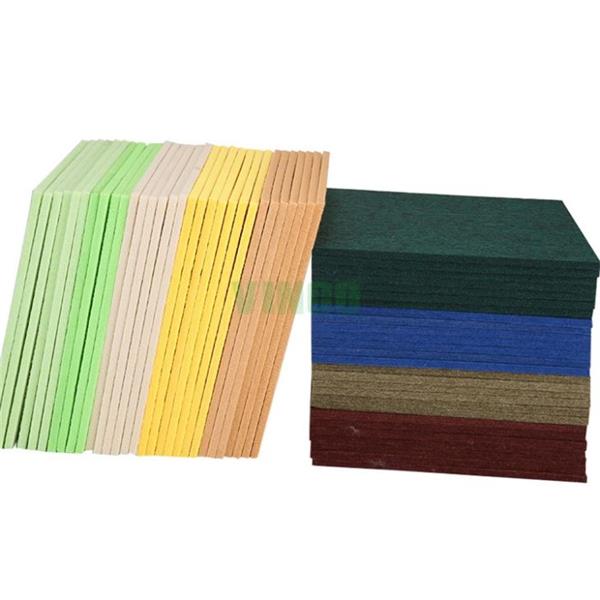The first type of sound-absorbing board-polyester fiber sound-absorbing board
The polyester fiber sound-absorbing board is made of 100% polyester fiber as the basic material, and is made by high-temperature hot pressing technology, which can meet the environmental protection E0 standard in terms of environmental protection. In terms of sound absorption coefficient, within the noise range of 125-4000HZ, with reasonable sound insulation materials, the highest sound absorption coefficient can reach 0.85 or more. Because of the super high sound absorption and noise reduction coefficient, it is often used in professional recording studios, studios, home theaters, and pianos. Professional vocal music venues such as rooms, theaters and playing halls are also suitable for meeting rooms, training classrooms, multi-function halls, KTVs and other places. In addition, because the products are relatively soft, they are often used for anti-collision walls in interrogation rooms and kindergartens.
The second commonly used sound-absorbing board-wooden sound-absorbing board
The basic materials generally selected for wooden sound-absorbing panels are density board, Aosong board (environmental E1 level), flame retardant board (flame retardant B1 level), which are perforated according to the principle of acoustics. Consisting of various aspects. The hole type can be divided into grooved wood sound-absorbing board and perforated wood sound-absorbing board. In terms of sound absorption coefficient, the wooden sound-absorbing board is in the noise range of 100-5000HZ, with the use of filled sound insulation cotton, the highest sound absorption coefficient can reach more than 0.75. In addition to super high sound absorption performance, wooden sound-absorbing panels also have decorative properties and durability. Some substrates are environmentally friendly and flame retardant. The pattern and color of wooden sound-absorbing panels can be customized according to personal needs, so they are mostly used in studios, live studios, recording studios, concert halls and other places where sound insulation needs but also aesthetics. It is also suitable for conference rooms, theaters, and gymnasiums. , Multifunctional meeting room and other places.
The third common type of sound-absorbing panel-ceramic aluminum sound-absorbing panel
The surface of the ceramic-aluminum sound-absorbing board is similar to that of the wooden sound-absorbing board, except that the basic material is ceramic aluminum board. The main raw material of the ceramic aluminum board is inorganic materials. The materials such as mixed conductive porcelain clay powder, conductive mica, and reinforcing fibers are passed through inorganic binders. Bonded. It has super stability and fire resistance. The fire protection rating can reach Class A, which fills in the selection of customers with higher fire protection requirements. The noise reduction effect on medium and high frequency noise is particularly obvious in terms of sound absorption coefficient. Its sound absorption coefficient is not affected by environment and time,
The fourth common type of sound-absorbing panel-perforated aluminum gusset
The perforated aluminum gusset is a perforated metal sound-absorbing board made of high-strength aluminum and aluminum alloy plates, designed according to different hole patterns, and through high-precision perforation. Holes of different shapes are distributed on the surface of the perforated aluminum gusset, so that while the traditional aluminum gusset increases the aesthetics, it also enhances the sound absorption and noise reduction effect. There are many factors that affect the sound absorption performance of aluminum gusset plates, such as aluminum plate thickness, hole diameter, hole spacing, perforation rate, plate coating material, thickness of air layer behind the plate, etc. Generally, industrial plants, generator rooms, water pump rooms, etc. are recommended. Used in sound insulation and noise reduction projects in industrial places such as air-conditioning room and equipment room.
The fifth common sound-absorbing panel-calcium silicate sound-absorbing panel
Calcium silicate sound-absorbing board is a new type of inorganic sound-absorbing material mainly made of siliceous materials, calcium materials, reinforced fiber materials, etc. The strength of calcium silicate sound-absorbing board is much higher than that of ordinary gypsum board. It is strong and not easy to be damaged and cracked. It is a very environmentally friendly sound insulation and noise reduction material with good sound absorption performance. Because of the solidity of calcium silicate sound-absorbing board, it is commonly used It is used in the sound insulation and decoration of industrial construction projects, and is suitable for use in the sound insulation and noise reduction projects of industrial plants, generator rooms, pump rooms, air-conditioning rooms, equipment rooms and other industrial places. The applicable place is similar to the perforated aluminum gusset, but it is much cheaper than the perforated aluminum gusset in terms of cost.
The sixth common type of sound-absorbing board-mineral wool sound-absorbing board
Mineral wool sound-absorbing board is made of mineral wool as the main material. It has good thermal insulation and flame retardant performance. The thermal conductivity of mineral wool board is small, easy to heat insulation, and has high fire resistance. It is a high-efficiency and energy-saving building sound insulation material. The surface treatment methods of the cotton board are diverse, and the board has a strong decorative effect. The surface can be knurled, punched, coated, sanded, etc., and the surface can be made into large and small squares, stripes of different widths and narrow stripes. The cost of mineral wool board is low, and it is generally suitable for indoor public ceilings. It is also suitable for sound insulation and noise reduction projects in industrial plants, generator rooms, water pump rooms, air-conditioning rooms, equipment rooms and other places.
Post time: Aug-04-2021





